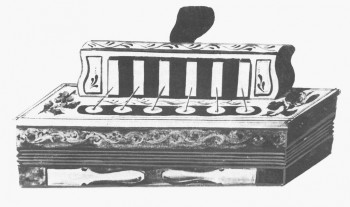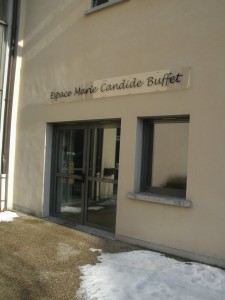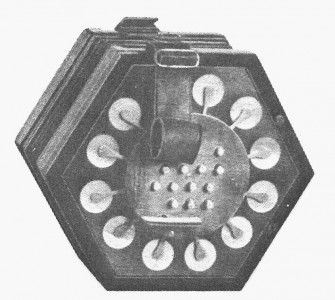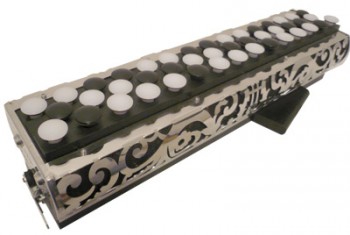Harmonica... Accordéon... Accordina...
The first 20 years of the nineteenth century were prolific in inventions, starting with the harmonica and its many derivatives, fruit of imaginative inventors and perfectionistic to the extreme ...
I invite you to revisit with my inventions of this period in the field of the free reed, which after a series of successive mutations will result in the birth of the accordion.

We are in 1821, in Germany, Christian Friedrich Buschmann invented a small instrument, the Aura, 10cm long, with 15 metal strips that vibrate in the breeze. The aura is simple, almost foolproof and has the characteristics of the harmonica as we know it.
1822 - Following its invention in the previous year, Friedrich Buschmann imagine to associate a small bellows to the Aura, demonstrating that it was be possible to substitute mechanical breathing to human breath. The first fruit of this experience will be baptized Handäoline (hand éoline, photo).
The succession of inventions that will follow, starting from the same reasoning, shows that Buschmann was indeed the precursor of the accordion (which later became the "accordéon").
1827 — In Paris, Marie Candide Buffet, tuner by trade, invented the metal mouth harmonica (photo below), in his workshop in Rue des Blancs Manteaux, Paris, fourth arrondissement. Buffet's company will experience a rapid and successful development, forcing him to distribute the production in private homes in town. One of them, Jacob Alexander, created in turn, in 1928, a firm specializing in the manufacturing of these instruments.
The number of instruments that will be invented at that time will not cease to grow. What will bring Buffet Marie Candide to move into larger premises, rue des Francs Bourgeois in the Marais.

Having reached the same conclusions as Christian Friedrich Buschmann, he invented a new instrument based on the principle of mechanical bellows called the accordion, of which he will he will therefore ensure the production.
It seems that with some others (Buffon, Wheatstone, Demian, Hohner, etc.), M.C. Buffet has manufacture and sell this new instrument. He will do so until 1837, in collaboration with Mathieu François Isoard, mechanic luthier, always anxious to improve the instrument. He died in 1859 at the age of 62. He will remain a symbol of the passage of the harmonica to accordion.
(Photo Marie Candide Buffet Space, Orgelet, his city of birth, National Heritage Site / Franche Comté).
1829 — Cyril Demian creates the Hand Harmonica, taking out a patent in Vienna May 6, 1829, using the concept borrowed from Christian Friedrich Buschmann handäoline, to replace the human breath by a mechanical bellows.
1829 — the same year in England, Charles Wheatstone invented a small hexagonal instrument similar to the accordion, the concertina, transforming his first invention, the mouth Symphonium (1825) into a Bellows Symphonium (photo below) .

Which will result in 1840/1849 with the invention of the Bandoneon by Heinrich Ban, Germany, whose first models, although square instead of hexagonal, suggested a similarity with the Wheatstone concertina, and, other similarity the gestures of the musicians, a sign of belonging to the same instrumental family.
It is clear that without the invention of the harmonica, the accordion would probably never have emerged at this time.
From Accordion ... to Accordina
1943 — A century later ... The free reed, already generating multiple inventions, re-enters the creative game of musical chairs, which brings us back to square one ... back to the mouth organ with the invention of the accordina.
This hybrid instrument is naturally between accordion and harmonica.
Conceived by André Borel in the 30s, the accordina was patented in December 1943. It borrows from the accordion, its free-reed and chromatic keyboard (44 notes, three and a half octaves). It takes from the harmonica the use of wind produced by the musician and its two side flaps that can modulate the sound, as does the harmonica player with his hands.
The hybrid side of this instrument will harm it long, targeting, wrongly perhaps, an accordionistic public, excluding the area of wind instrument.
Today, Richard Galiano, Francis Jauvin , Daniel Mille, Jean Louis Matinier, Roland Romanelli and Jacques Bolognesi are using it to explore many musical styles: jazz, French songs (Georges Moustaki, touring, preferred the Jouvin accordina to the traditional accordion).
During its history, the accordina will experience several forms of manufacturing. The largest changes occur in the late 50s. The music changed, we must adapt. The brass reeds of the first models will be replaced by stainless steel. Among the new productions, there are "gold" and "silver" models made in the late 60s by Paolo Soprani.
Forgotten for a long time, the accordina rose from its ashes in 1995, rebirth due to Laurent Jarry and Marcel Dreux, since 2002 *.

The different models
— The button accordina
The original was designed and built by André Borel. The 2000 version of Marcel Dreux is a true copy of this instrument with a main change : a plastic mattress. Marcel Dreux produced the 2004 model, taking into account users requirements by replacing the side vents, delicatly cut, allowing the hands to better modulate the sound, and incorporating a pullout, interchangeable (washable). Add to this a very useful coloured keyboar, making it easier to locate.
The sound is warm and powerful. The range covers 3.5 octaves from F to C.
— The piano accordina
It has been designed thinking of the many accordionists playing the piano keyboard, but also of all pianists, penalized by a heavy instrument, who can now carry under their arms a tool that will allow them to more easily integrate in groups, off the cuff.
It offers a range that covers three octaves, from A to A,tuned to 442 Hz
— The Diatonic accordina
This is a accordina said : "2004 buttons". It is united with a sound that matches the fingering of a diatonic 3-rows. It has a warm, powerful sound. It covers 3.5 to 442 Hz octave granted.
The sound of the accordina is so close to the harmonica that I once caught myself listening to recordings ... taking one for the other. The accordina fits happily contemporary music, jazz in particular.
What a progress since the aura of Christian Friedrich Buschmann, and even more since the Chinese Emperor Huang-ti (Huangdi), inventor, 4500 years ago of the Sheng *, ancestor of the harmonica ...
The free reed has probably not finished surprising. The future will tell, stay alert to the round of musical chairs ...
Jean Labre
Sources : Candide Mary Buffet Biography, Trossingen Harmonica Museum, Albert Raisner, Pierre Monichon, Marcel Dreux, excerpts from « The Harmonica Encyclopedia » , Jean Labre, late in writing.
* This is a photo of a Japanese Sho, which appeared in the eighth century, extension of the Chinese sheng.
Photos: Buffet TM Museum, Hohner Harmonica Trossingen museum, Wheatstone museum, Marcel Dreux, Micheline Vicent / Roubert, Agnes Menouillard. </ i>
Copyright © 2012 Jean Labre
Published February 19th 2012
|

